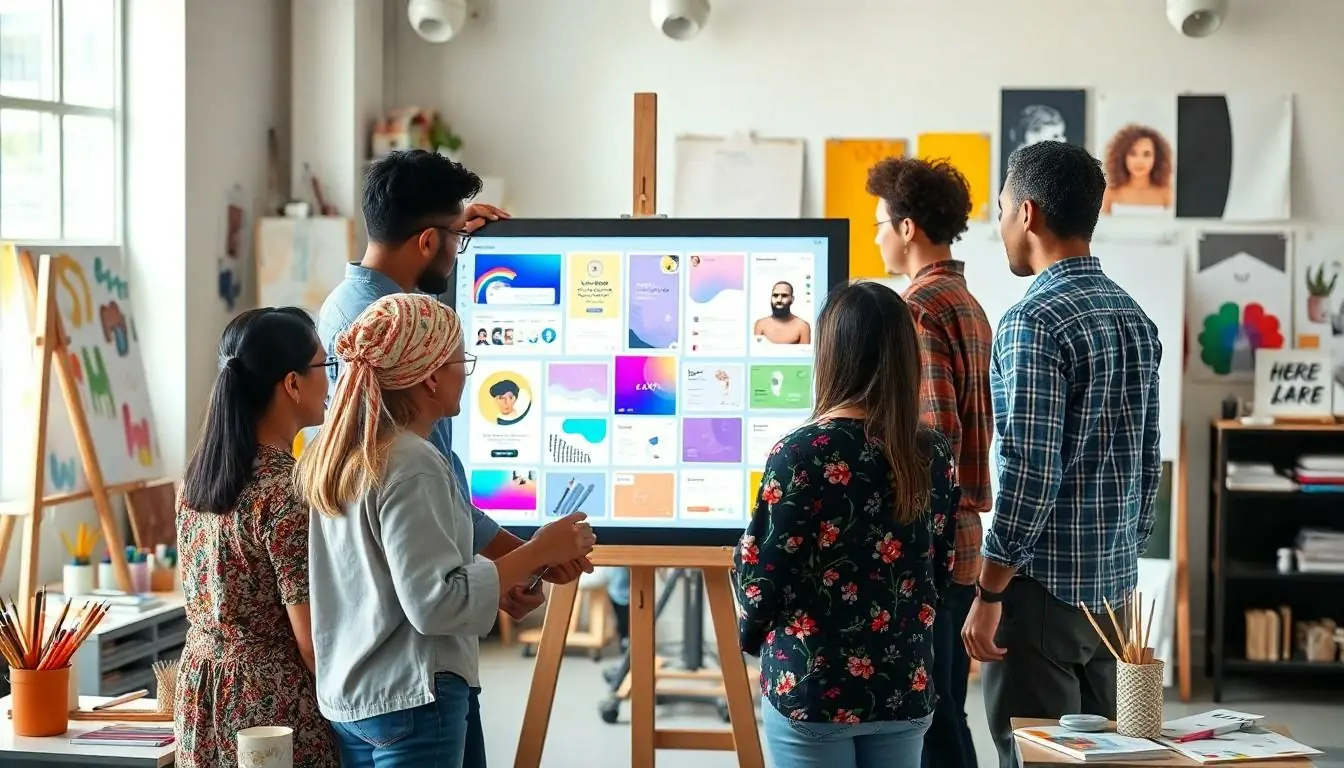Once hailed as the creative playground for users, ChatGPT Canvas has mysteriously vanished from the spotlight. Picture it: a vibrant space where ideas flowed like coffee on a Monday morning, inspiring users to unleash their inner Picasso. But now, whispers of its disappearance have left many scratching their heads and wondering what went wrong.
Table of Contents
ToggleOverview of ChatGPT Canvas
ChatGPT Canvas was a unique platform designed for creativity and artistic expression. Users engaged with diverse tools that facilitated brainstorming and visual storytelling. Many artists, writers, and content creators found inspiration within its interactive environment.
Formerly, the Canvas featured functionality that allowed for the seamless creation of mind maps, sketches, and other creative outputs. People often shared their projects, fostering a community where ideas flourished. Collaborative efforts thrived as individuals combined their talents and perspectives.
Suddenly, ChatGPT Canvas disappeared without prior notice. Users experienced confusion regarding the reasons behind this unexpected change. Speculations arose about platform updates, potential technical issues, or shifts in strategic direction by the developers.
Interest in the platform remains high, despite its absence. Many users continue to seek alternatives that provide similar functionalities. Current discussions revolve around what could replace the unique features once offered by ChatGPT Canvas.
Several users expressed concerns over losing a valuable tool for creativity and collaboration. The need for accessible platforms that support artistic endeavors emphasizes the ongoing demand in the digital space. Insights gathered from the community highlight a longing for an effective solution that captures the essence of ChatGPT Canvas.
Features of ChatGPT Canvas

ChatGPT Canvas once stood out for its innovative tools designed to enhance creativity and collaboration. Users enjoyed a rich set of functionalities that catered to diverse artistic needs.
Key Functionalities
ChatGPT Canvas included brainstorming tools that encouraged the free flow of ideas. Users could create visual stories with an easy-to-navigate interface. Templates facilitated quick design processes and made it simple to start projects. Collaborative features allowed multiple users to work on a single canvas in real time. Integration with other applications expanded the platform’s usability and flexibility. Access to a library of resources further enriched the creative experience.
User Experience
The user experience on ChatGPT Canvas emphasized accessibility and ease of use. An intuitive layout guided users through their creative processes, minimizing any potential learning curve. Engaging with the community enhanced motivation and collaboration among creators. Feedback mechanisms enabled users to receive constructive critiques on their work. Mobile compatibility allowed for creativity on the go, making it easier for artists to share ideas anytime and anywhere. Overall, every interaction fostered a sense of belonging within the artistic community.
Impact on Users
The sudden removal of ChatGPT Canvas significantly affected its user community. Users expressed concern about losing a platform that uniquely supported their creative expressions and collaborative projects.
Community Feedback
Users voiced mixed feelings over the absence of ChatGPT Canvas. Many described it as a pivotal tool for their creative processes. Feedback channels once offered a space for constructive critiques, enhancing artistic development. Artists and content creators shared experiences of how the platform inspired them daily. Some suggested that they now feel directionless, searching for alternatives that match the original accessibility and ease of use. Others highlighted the importance of community engagement features, which fostered collaboration and encouraged networking among users. As discussions unfold, the desire for a solution that mirrors the essence of ChatGPT Canvas remains apparent.
Use Cases
Various use cases defined ChatGPT Canvas as an invaluable resource. Collaborative projects thrived on the platform, allowing multiple users to contribute to shared canvases in real time. Individuals utilized brainstorming tools for generating innovative ideas, speeding up the creative process. Many relied on its intuitive interface for crafting engaging visual stories, while templates simplified the project initiation. The platform’s mobile compatibility allowed creators to work anytime, anywhere. With its unique features still fresh in users’ minds, the quest for similar environments continues as many look to replicate the collaborative and creative potential once available on ChatGPT Canvas.
Changes and Updates
ChatGPT Canvas underwent significant changes before its unexpected removal. The innovative features set the platform apart, providing unique tools for brainstorming and visual storytelling. An easy-to-navigate interface made creating and collaborating intuitive for users. Templates simplified project initiation, enabling quick entry into creative processes.
Collaboration capabilities allowed real-time teamwork on single canvases. This engaging function fostered creativity among users, enhancing artistic exploration and community building. Integration with other applications broadened the platform’s usability, serving a diverse range of creative expressions.
Feedback mechanisms previously offered constructive critiques, essential for artistic development. Many users depended on this feature to refine their projects and share ideas. Mobile compatibility allowed creativity on the go, ensuring that artistic expression remained accessible regardless of location.
Users now express concern about losing such a vital tool. Feelings of uncertainty arise, as some struggle to find alternatives that match the original platform’s user-friendly attributes. Discussions reflect a longing for a solution that encapsulates the essence of ChatGPT Canvas, addressing the desire for accessible creative platforms.
Activating their creativity without the support of ChatGPT Canvas has proven challenging for many. The community feels directionless, as the collaborative projects that thrived within the platform are now stymied. Overall, the removal of ChatGPT Canvas leaves a notable gap in the realm of digital creativity, driving a demand for an innovative solution that resonates with its foundational ideals.
Future Prospects
Future developments for digital creativity platforms like ChatGPT Canvas may focus on enhancing user experience and expanding collaboration capabilities. Emerging competitors could introduce innovative features that replicate or improve upon the aspects users loved about Canvas. Community feedback will likely steer these advancements, ensuring platforms cater to artistic needs while fostering collaboration.
Users might expect to see improved tools for brainstorming and visual storytelling, prioritizing ease of navigation and intuitive design. The absence of ChatGPT Canvas highlights a market gap, driving demand for solutions that facilitate seamless project initiation through responsive templates. Integration with existing applications could become a standard feature, improving functionality and reach for new platforms.
Real-time collaboration may emerge as a dominant theme, allowing multiple users to work together effortlessly. Enhanced feedback mechanisms will serve to provide critiques and suggestions, essential for artistic growth and community building. Mobile compatibility should remain a priority, ensuring creativity stays accessible regardless of location.
As developers analyze the reasons behind Canvas’s popularity, they might create similar or better experiences that prioritize user engagement and satisfaction. Opportunities for partnerships with educational institutions could lead to tools specifically designed for learning environments, expanding the audience for creative platforms.
Prospective users may look for alternatives that offer the same level of community support and user-friendly interfaces. Anticipating trends in digital creativity could lead to innovative solutions that not only fill the void left by ChatGPT Canvas but also set new standards for collaborative platforms.
The disappearance of ChatGPT Canvas has left a significant void in the digital creativity landscape. Users are now seeking alternatives that can replicate the platform’s unique features and community-driven spirit. As the demand for innovative solutions grows, developers may take notice and strive to fill this gap with new tools that prioritize collaboration and user experience.
The future of digital creativity platforms looks promising, with potential advancements in real-time collaboration and intuitive design. As users continue to express their needs and preferences, it’s likely that new offerings will emerge, ensuring that the essence of what made ChatGPT Canvas special isn’t lost. The creative community remains hopeful for the next generation of platforms that will inspire and connect artists, writers, and creators once again.





